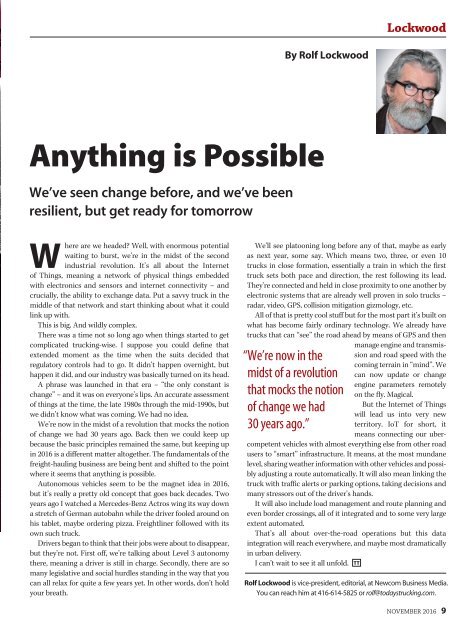DIGGING IN
2faRCNO
2faRCNO
Create successful ePaper yourself
Turn your PDF publications into a flip-book with our unique Google optimized e-Paper software.
Lockwood<br />
By Rolf Lockwood<br />
Anything is Possible<br />
We’ve seen change before, and we’ve been<br />
resilient, but get ready for tomorrow<br />
W<br />
here are we headed? Well, with enormous potential<br />
waiting to burst, we’re in the midst of the second<br />
industrial revolution. It’s all about the Internet<br />
of Things, meaning a network of physical things embedded<br />
with electronics and sensors and internet connectivity – and<br />
crucially, the ability to exchange data. Put a savvy truck in the<br />
middle of that network and start thinking about what it could<br />
link up with.<br />
This is big. And wildly complex.<br />
There was a time not so long ago when things started to get<br />
complicated trucking-wise. I suppose you could define that<br />
extended moment as the time when the suits decided that<br />
regulatory controls had to go. It didn’t happen overnight, but<br />
happen it did, and our industry was basically turned on its head.<br />
A phrase was launched in that era – “the only constant is<br />
change” – and it was on everyone’s lips. An accurate assessment<br />
of things at the time, the late 1980s through the mid-1990s, but<br />
we didn’t know what was coming. We had no idea.<br />
We’re now in the midst of a revolution that mocks the notion<br />
of change we had 30 years ago. Back then we could keep up<br />
because the basic principles remained the same, but keeping up<br />
in 2016 is a different matter altogether. The fundamentals of the<br />
freight-hauling business are being bent and shifted to the point<br />
where it seems that anything is possible.<br />
Autonomous vehicles seem to be the magnet idea in 2016,<br />
but it’s really a pretty old concept that goes back decades. Two<br />
years ago I watched a Mercedes-Benz Actros wing its way down<br />
a stretch of German autobahn while the driver fooled around on<br />
his tablet, maybe ordering pizza. Freightliner followed with its<br />
own such truck.<br />
Drivers began to think that their jobs were about to disappear,<br />
but they’re not. First off, we’re talking about Level 3 autonomy<br />
there, meaning a driver is still in charge. Secondly, there are so<br />
many legislative and social hurdles standing in the way that you<br />
can all relax for quite a few years yet. In other words, don’t hold<br />
your breath.<br />
“ We’re now in the<br />
midst of a revolution<br />
that mocks the notion<br />
of change we had<br />
30 years ago.”<br />
We’ll see platooning long before any of that, maybe as early<br />
as next year, some say. Which means two, three, or even 10<br />
trucks in close formation, essentially a train in which the first<br />
truck sets both pace and direction, the rest following its lead.<br />
They’re connected and held in close proximity to one another by<br />
electronic systems that are already well proven in solo trucks –<br />
radar, video, GPS, collision mitigation gizmology, etc.<br />
All of that is pretty cool stuff but for the most part it’s built on<br />
what has become fairly ordinary technology. We already have<br />
trucks that can “see” the road ahead by means of GPS and then<br />
manage engine and transmission<br />
and road speed with the<br />
coming terrain in “mind”. We<br />
can now update or change<br />
engine parameters remotely<br />
on the fly. Magical.<br />
But the Internet of Things<br />
will lead us into very new<br />
territory. IoT for short, it<br />
means connecting our uber-<br />
competent vehicles with almost everything else from other road<br />
users to “smart” infrastructure. It means, at the most mundane<br />
level, sharing weather information with other vehicles and possibly<br />
adjusting a route automatically. It will also mean linking the<br />
truck with traffic alerts or parking options, taking decisions and<br />
many stressors out of the driver’s hands.<br />
It will also include load management and route planning and<br />
even border crossings, all of it integrated and to some very large<br />
extent automated.<br />
That’s all about over-the-road operations but this data<br />
integration will reach everywhere, and maybe most dramatically<br />
in urban delivery.<br />
I can’t wait to see it all unfold. TT<br />
Rolf Lockwood is vice-president, editorial, at Newcom Business Media.<br />
You can reach him at 416-614-5825 or rolf@todaystrucking.com.<br />
NOVEMBER 2016 9


